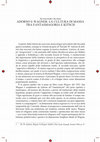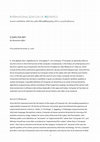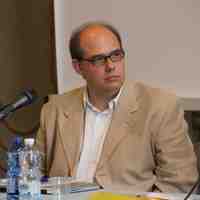Papers by Alessandro Alfieri
Rivista di estetica, 2016
The paper proposes a focus upon two tendencies of contemporary music; the first is Minimalism, mo... more The paper proposes a focus upon two tendencies of contemporary music; the first is Minimalism, movement represented by musicians like La Monte Young, Philip Glass and Steve Reich, the second one is the rave music (like techno), feature of popular culture and postmodernist age. Through Adorno's thought, and starting from his dialectical analysis about the dualism Schönberg-Stravinskij, this essay aims a philosophical understanding of concepts like "repetition" and "lack of transcendence"; the absence of development in a lot of musical production of the last decades, in popular music as much as in classical music, is demonstration of a loss of subject, where the "eternal return" of the rhythmic structure can be understood in terms of "eternal return of the same" and not in terms of "eternal return of possibility".
The storytelling of the end of the world has always represented in the cultural horizon an essent... more The storytelling of the end of the world has always represented in the cultural horizon an essential speculative principle, because the fear for the catastrophe is one of the most effective principles to mark the collective imaginary; in the last years, the perverse attraction for global destruction has been re-launched by popular culture. This essay examines how, in the age of international terrorism, natural cataclysms and economic crisis, several series (The Handmaid's Tale, Mr. Robot, The Walking Dead) and videos (The Suburbs – Arcade Fire, Incantevole – Subsonica, Waiting for a Sign – Scratch Massive ft. Koudlam), tell us about the collapse of the liberal-democratic system without a positive alternative, where dystopia takes on a metaphorical meaning.

Estetica. Studi e Ricerche. Shakespeare e la filosofia. Tra Sogno di una notte di mezza estate e La tempesta, 2021
Among the film adaptations of Shakespeare’s works, Derek Jarman’s The Tempest (1979) and Peter Gr... more Among the film adaptations of Shakespeare’s works, Derek Jarman’s The Tempest (1979) and Peter Greenaway’s Prospero’s Books (1991) appear today the most particularly movies from aesthetic-theoretical and expressive-formal perspectives. The vitality and the complexity of Shakespearian play The Tempest is able to renewing languages and meanings, and its audacious aesthetic is present also in film language, that includes video-artistic experiments. The particular narrative construction of Shakespeare’s text, including the strong metatextual dimension that characterizes it, offers the opportunity to rethink the role and the function of narration and its relationship with the imaginary of different historical periods. These two movies, united by the refusal of a linear correspondence between film expression and dramaturgical language, are dated 1979 and 1991, two particular phases of contemporary western culture: the origin of the hedonistic and hyper-spectacularized imaginary of the 80s, the end of that season and a necessary re-understanding of the video-electronic expressive imaginary
eSamizdat , Dec 31, 2021
Starting from an analysis of the music video of the song 911 from Lady Gaga’s Chromatica album, t... more Starting from an analysis of the music video of the song 911 from Lady Gaga’s Chromatica album, the article aims to relate two characters and two seemingly irreconcilable cultural horizons: the Georgian-Armenian director Sergei Paradzhanov and contemporary American pop icon Lady Gaga. Paradzhanov’s masterpiece The Color of the Pomegranate (1969) clearly inspired Lady Gaga’s 2020 video. In addition to a tribute to Paradzhanov’s unforgiving style, the video directed by Indian-born videomaker and director Tarsem Singh Dhandwar is not only an exercise in style, but it effectively expresses some of the characteristic elements of the link between the modern-day star system and the sacred dimension, between the pop imagery and religion.
Ideasonair. Blogging as an Open Art Project, 2021
Aisthema, Volume VIII (2021), numero 1, 2021
Il saggio intende offrire alcuni spunti di riflessione a partire dalla questione dello stile appl... more Il saggio intende offrire alcuni spunti di riflessione a partire dalla questione dello stile applicata alla moda e all'immaginario contemporaneo. Facendo riferimento ad alcuni contributi teorici e sociologici celebri come quelli di John Clarke e Pierre Bourdieu, si intende mettere in evidenza i paradossi e i "capovolgimenti dialettici" avvenuti nel corso di differenti episodi della cultura moderna e postmoderna: dal gusto aristocratico dello stile di un fotografo e art director della prima metà del Novecento come Alexey Brodovitch, alla visione neobarocca legata all'eccesso di alcuni brand e fashion designer particolarmente fortunati degli ultimi anni, che hanno espresso con la loro produzione, in maniera paradossale, la rivendicazione di riscatto sociale da parte delle giovani generazioni attraverso l'ostentazione del lusso.

Innovation in Urban and Regional Planning. Proceedings of the 11th INPUT Conference - Volume 1, 2021
According to the theory of the Spanish sociologist Manuel Castells, with the transition to the ne... more According to the theory of the Spanish sociologist Manuel Castells, with the transition to the new millennium, we have attend the advent of new information technologies that have conditioned society so much that they have led to the transition from industrial capitalism to informational capitalism. Informational capitalism has defined a new social form, the Network Society, and has determined the subordination of the Space of Places under the pressure of the Space of Flows, the space within which information moves. How to give a new meaning to physical places immersed in the Space of Flows? How to contrast the global logic of the Information Age and recover the local character of communities? Urban planning can give answers to these questions by triggering bottom-up processes capable of giving voice to the socio-historical identities of individual communities.

Paradigmi, 2021
The genre “Video Artµ draws on a diverse range of art movements, theoretical ideas, and technolog... more The genre “Video Artµ draws on a diverse range of art movements, theoretical ideas, and technological advances, but also on political and social activism, like for the case of “Guerrilla TVµ. Video Art has moved from short videotapes to video installations, embracing several artistic ideas of the last decades – from Conceptual, Minimal, Performance, Pop Art to photography and film. At the beginning, in a period of social, economic and cultural change like the 60’s, Video Art was formally and politically radical: artists who took up working with video in this period were highly influenced by movements and ideas from Fluxus and Body Art (cf. Westgeest, 2016). For these reasons, Video Art highlights the problems of the autonomy of art and the social meaning of art from different points of view, arising this radicality from experimental cinema of the first years of the 20 th century. Theodor W. Adorno, one of the most important theorists of the autonomy of art, offers us the theoretical-aesthetic tools to understand the fate of the concept of autonomy in relation to the evolution of video-culture, without ever talking about Video or Digital Art. Adorno’s position is deeply different from the theory of Expanded Cinema by Gene Youngblood, one of the most important study about this genre of art.
Aesthetica | Preprint, No. 112 (2019). "Adorno e la teoria estetica (1969-2019). Nuove prospettive critiche"
coordinamento redazione: Leonardo Distaso (Università degli Studi di Napoli Federico II) segreter... more coordinamento redazione: Leonardo Distaso (Università degli Studi di Napoli Federico II) segreteria di redazione: Giacomo Fronzi (Università del Salento), Lisa Giombini (Università degli Studi Roma Tre), Leonardo Monetti Lenner (Università degli Studi
Scenari #11 - Rivista semestrale di filosofia contemporanea. "Fare il postumano: Un nuovo scenario della teoria e della pratica artistica", 2019
International Lexicon of Aesthetics, 2019
It.: Videoclip musicale; Fr.: Clip musical; Germ.: Musik-Video; Span. Video musical. Music Video ... more It.: Videoclip musicale; Fr.: Clip musical; Germ.: Musik-Video; Span. Video musical. Music Video is a promotional short-film for several genres of popular music (pop, rock, disco, rap, etc.); it is a video rendition of a recorded song, often showing the musicians performing or a dramatic interpretation of the lyrics or the mood of the song, sometimes through a series of surreal and abstract images.

Prospettive su Wagner. Filosofia, Musica, Letteratura, 2019
A partire dalla lettura dei suoi testi musicologici precedenti alla Seconda nire due tracciati ch... more A partire dalla lettura dei suoi testi musicologici precedenti alla Seconda nire due tracciati che hanno segnato la musica moderna: il primo, di stampo "progressista" e che partendo dall'ultimo Beethoven passa per Mahler e approda a Schönberg e alla seconda Scuola di Vienna, è caratterizzato dal superamento della struttura classica in prospettiva di un rinnovamento linguistico e grammaticale, in grado di dare espressione allo sviluppo da la stessa rigidità della tradizione tonale. Il secondo tracciato, quello "oppositivo-dialettico" di natura regressiva, prende origine dal sinfonismo beethoveniano, nel quale si trova esaltata l'idea della composizione totale e chiusa, passa per la musica di Richard Wagner, e trova in Igor Stravinskij la sua attuazione novecentesca: il principio di questa linea è la lotta contro il tempo, e perciò contro il divenire e lo sviluppo intesi come dimensioni propriamente moderne. È in questo quadro che si pone un libro come Wagner del 1952. Qui Wagner è condannato da Adorno all'"inautenticità" del gesto ripetuto e tautologico, all'assenza del divenire e perciò all'esaltazione della totalità hegeliana, proprio perché l'apparente sviluppo in realtà cede all'identità: "Ogni ripetizione di gesti si sottrae alla necessità di fondare il tempo mu-
Philosophy Kitchen #10: Filosofia e fantascienza. Spazi, tempi e mondi altri, 2019
The storytelling of the end of the world has always represented in the cultural horizon an essent... more The storytelling of the end of the world has always represented in the cultural horizon an essential speculative principle, because the fear for the catastrophe is one of the most effective principles to mark the collective imaginary; in the last years, the perverse attraction for global destruction has been re-launched by popular culture. This essay examines how, in the age of international terrorism, natural cataclysms and economic crisis, several series (The Handmaid’s Tale, Mr. Robot, The Walking Dead) and videos (The Suburbs – Arcade Fire, Incantevole – Subsonica, Waiting for a Sign – Scratch Massive ft. Koudlam), tell us about the collapse of the liberal-democratic system without a positive alternative, where dystopia takes on a metaphorical meaning.

INTERNATIONAL LEXICON OF AESTHETICS, 2019
It. Arte digitale; Deut. Digitalkunst; Es. Arte digital; Fr. Art numérique. If Computer art gener... more It. Arte digitale; Deut. Digitalkunst; Es. Arte digital; Fr. Art numérique. If Computer art generally refers to any form of art in which the function of the computer is emphasized, in the history of contemporary art it became a specific way of expression into the horizon of Digital art, New Media art or Video art, which include all the artistic productions generated by electronic devices and technological tools. Since the first forms of expressive experimentation by Computer artists (in the 1960s with John Whitney and Charles Csuri, in the late 1970s and early 1980s with the work of Larry Cuba), Computer art has not been a movement and there has not been a manifesto: it gives no indication of specific aesthetic qualities or stylistic techniques. A possible definition of Computer art should focus on works of art produced by algorithmic programming, without translation of the image from analogic recording of the real but with direct production in software code writing. Especially in the 1990s and today, Computer art has been an important source of inspiration for audiovisual-movie industry and video-music products.
Azioni parallele, Mar 7, 2018
Insight - I territori della grafica, 2018
Letture shakespeariane: Otello e Re Lear, 2017
The essay highlights the meaning of Cordelia's silence, within the plot of King Lear, in relation... more The essay highlights the meaning of Cordelia's silence, within the plot of King Lear, in relation to the category of " cynicism " , outlined in contemporary philosophy by Michel Foucault and Peter Sloterdijk. Through the studies of David Her-shinow and Massimo Cacciari about King Lear, the dialectical nature of cynicism becomes evident: on the one hand cynicism in its immoral and negative connotation , and on the other hand kinism as revolutionary rejection of public conventions .
La festa, Oct 2016
Col·loquis de Vic | 20 la fes_ta 1 -2 d'octubre de 2015 Els Col·loquis de Vic (CdV) són una troba... more Col·loquis de Vic | 20 la fes_ta 1 -2 d'octubre de 2015 Els Col·loquis de Vic (CdV) són una trobada i un debat entre els professionals de les humanitats i els millors especialistes universitaris del moment per tal d'aprofundir un tema comú.
Rivista di estetica - Contemporaneo n. 61/2016, Jun 2016
The paper propos a focus upon two tendencies of contemporary music; the first is Minimalism, move... more The paper propos a focus upon two tendencies of contemporary music; the first is Minimalism, movement represented by musicians like La Monte Young, Philip Glass and Steve Reich, the second one is the rave music (like techno), feature of popular culture and postmodernist age. Through Adorno's thought, and starting from his dialectical analysis about the dualism Schonberg-Stravinskij, this essay aims a philosophical understanding of concept like “repetition” and “lack of trascendence”; the absence of development in a lot of music production of the last decades, in popular music as much as in classical music, is demonstration of a loss of subject, where the “eternal return” of the rhythmic structure can be understood in terms of “eternal return of the same” and not in terms of “eternal return of possibility”.








Uploads
Papers by Alessandro Alfieri
ed. by Stefano Marino and Andrea Schembari,
Bloomsbury Academic Publishing, London-New York 2022.
The first scholarly discussion on the band, "Pearl Jam and Philosophy" examines both the songs (music and lyrics) and the activities (live performances, political commitments) of one of the most celebrated and charismatic rock bands of the last 30 years. The book investigates the philosophical aspects of their music at various levels: existential, spiritual, ethical, political, metaphysical and aesthetic. This philosophical interpretation is also dependent on the application of textual and poetic analysis: the interdisciplinary volume puts philosophical aspects of the band's lyrics in close dialogue with 19th- and 20th-century European and American poetry. Through this widespread philosophical examination, the book further looks into the band's immense popularity and commercial success, their deeply loyal fanbase and genuine sense of community surrounding their music, and the pivotal place the band holds within popular music and contemporary culture.
Table of Contents
Preface
Theodore Gracyk, Minnesota State University, USA
Introduction
Stefano Marino, University of Bologna, Italy, and Andrea Schembari, Univesity of Szczecin, Poland
1. Contingency, (In)significance, and the All-Encompassing Trip: Pearl Jam and the Question of the Meaning of Life
Stefano Marino, University of Bologna, Italy
2. “Just Like Innocence”: Pearl Jam and the (Re)Discovery of Hope
Sam Morris, University of South Carolina Beaufort, USA
3. Who's the Elderly Band Behind the Counter in a Small Town?
Radu Uszkai, Bucharest University of Economic Studies, Romania, and Mihail-Valentin Cernea, Bucharest University of Economic Studies, Romania
4. Making a Choice When There Is No “Better Man”
Laura M. Bernhardt, University of Southern Indiana, USA
5. That's Where We're Living: Determinism and Free Will in “Unthought Known”
Enrico Terrone, University of Torino, Italy
6. No Code Aesthetics
Alberto L. Siani, University of Pisa, Italy
7. Can Truth Be Found in the Wild?
Paolo Stellino, Nova Institute of Philosophy, Portugal
8. “They Can Buy, But Can't Put On My Clothes”: Pearl Jam, Grunge, and Subcultural Authenticity in a Postmodern Fashion Climate
Stephanie Kramer, Independent Scholar
9. Pearl Jam's Ghosts: The Ethical Claim Made From the Exiled Space(s) of Homelessness and War-An Aesthetic Response-Ability
Jacqueline Moulton, Institute for Doctoral Studies in the Visual Arts, USA
10. Pearl Jam: Responsible Music or the Tragedy of Culture?
Cristina Parapar, Sorbonne University (Paris IV), France
11. Pearl Jam / Nirvana: A Dialectical Vortex that Revolves around the Void
Alessandro Alfieri, Accademia Delle Belle Arti Di Roma, Italy
12. The Tide on the Shell: Pearl Jam and the Aquatic Allegories of Existence
Andrea Schembari, Univesity of Szczecin, Poland
Due to the incessant and fast-paced upgrades internet is subject to, many web-based art projects risk digital oblivion. Ideasonair by Chiara Passa sets out to be a restoration project of a net artwork that for seven years existed in the form of a blog. Starting specifically from her work, this book grapples with many of the questions circulating among those dealing with digital art, its conservation, and its spread. Essays by Alessandro Alfieri, Laura Barreca, Valentino Catricalà, Elena Giulia Rossi, Antonello Tolve and Chiara Passa herself, explore contemporary and cross-sectional subjects touching on aesthetics, media theories, art critique and philosophy: from digital art conservation to the transmedial nature of ideas, and from heterotopic memory spaces set between reality and virtuality to ideas converted into software objects.
The book (ENG.): https://en.silvanaeditoriale.it/libro/9788836649112
ITA: https://www.silvanaeditoriale.it/libro/9788836649112
Galassia Netflix risponde a questi interrogativi partendo proprio dall’analisi di alcune fra le serie più fortunate degli ultimi anni, concentrando l’attenzione sulle modalità estetico-formali di messa in scena e di racconto serializzato prima e dopo, rintracciando quelle tematiche che sembrano ripetersi con una certa ciclicità e conducendo un’accurata riflessione sulla nostalgia, sulla distopia e sugli eroi cinici e privi di scrupoli che stanno diventando i modelli di riferimento di intere generazioni.
più che la bellezza, l’alieno e il mostruoso più che il glamour. Come risulta evidente nella sua produzione videomusicale, che come per
i servizi fotografici annovera i migliori professionisti e creativi del settore, nella sua ricerca Lady Gaga ha lavorato sempre sulla polarità tesa
tra concetti inconciliabili: amore/odio, nascita/morte, naturale/artificiale, umano/inumano. Attraverso l’analisi dei suoi video, facendo riferimento all’outfit, al fashion design e all’apparato estetico complessivo (dalle scenografie alle coreografie, dalle tecniche di ripresa alle ambientazioni), questo importante saggio mette in evidenza come proprio il videoclip musicale, testo postmoderno per eccellenza, si dimostri non solo una delle modalità espressive più efficaci del circuito massmediale contemporaneo, ma soprattutto uno degli ambiti più produttivi di rinnovamento estetico.
Se la popular music ha spesso avuto la tendenza di occultarla la catastrofe, è anche vero che in diverse occasioni, come è prerogativa dell’arte matura, essa ha offerto formule di “accettazione” che possono diventare opportunità di emancipazione e speranza per il mutamento. Il presente saggio propone una classificazione filosofica di alcune delle realtà musicali italiane più significative emerse negli ultimi anni, dai Teatro degli Orrori alle Luci della Centrale Elettrica, dai Cani ai Pan Del Diavolo, dagli Offlaga Disco Pax ai Ministri, per evidenziarne le differenti modalità di risposta alla catastrofe, che resta sempre ben presente sullo sfondo di tutte le loro produzioni; in tutti questi artisti, in un modo o nell’altro, la catastrofe si declina nella crisi delle relazioni interpersonali, nella necessità della fuga, nel timore del sopraggiungere della fine, nel tentativo di rifugiarsi nel passato oppure nella volontà di immergersi in questi tempi bui, nella consapevolezza che l’unica forma sensata di speranza, soprattutto oggi, è quella di chi non ha più alcun futuro.
Fare il postumano. Un nuovo scenario della teoria e della pratica artistica a cura di Gabriela Galati
Fare il postumano: Un nuovo scenario della teoria e della pratica artistica
è la raccolta di una serie di articoli dedicati al tema dell’arte e del postu- mano. Originalmente l’idea era di realizzare un unico numero dedicato al tema, ma la quantità di lavori di rilievo ci ha convinto a dedicarvi due numeri, dei quali si presenta il primo.
Questi lavori hanno reso evidente quanto si dimostri pressante in questo momento ri ettere e declinare gli sviluppi teorici e critici del postumano alle diverse aree della pratica artistica. L’accelerazione espo- nenziale nello sviluppo tecnologico durante l’ultimo secolo ha portato a porsi delle domande sui cambiamenti nei rapporti tra uomo e tecnologia, e, quasi allo stesso tempo, sul vivente nel suo complesso. Da una parte queste domande sono state motivate dalla comprensione che l’intreccio costante con le nuove tecnologie stava generando nuovi e più complessi tipi identitari; dall’altro, che la teoretica predominanza umana su altre forme di vita non era più né sostenibile né tanto meno accettabile. Molte delle ricerche al riguardo venivano proposte sotto il nome di postuma- no: una “condizione” che implica un avanzamento dell’interesse verso una visione della contemporaneità più complessa, che mette sullo stesso piano tutte le forme di vita prendendo in considerazione anche i rapporti con l’inorganico.